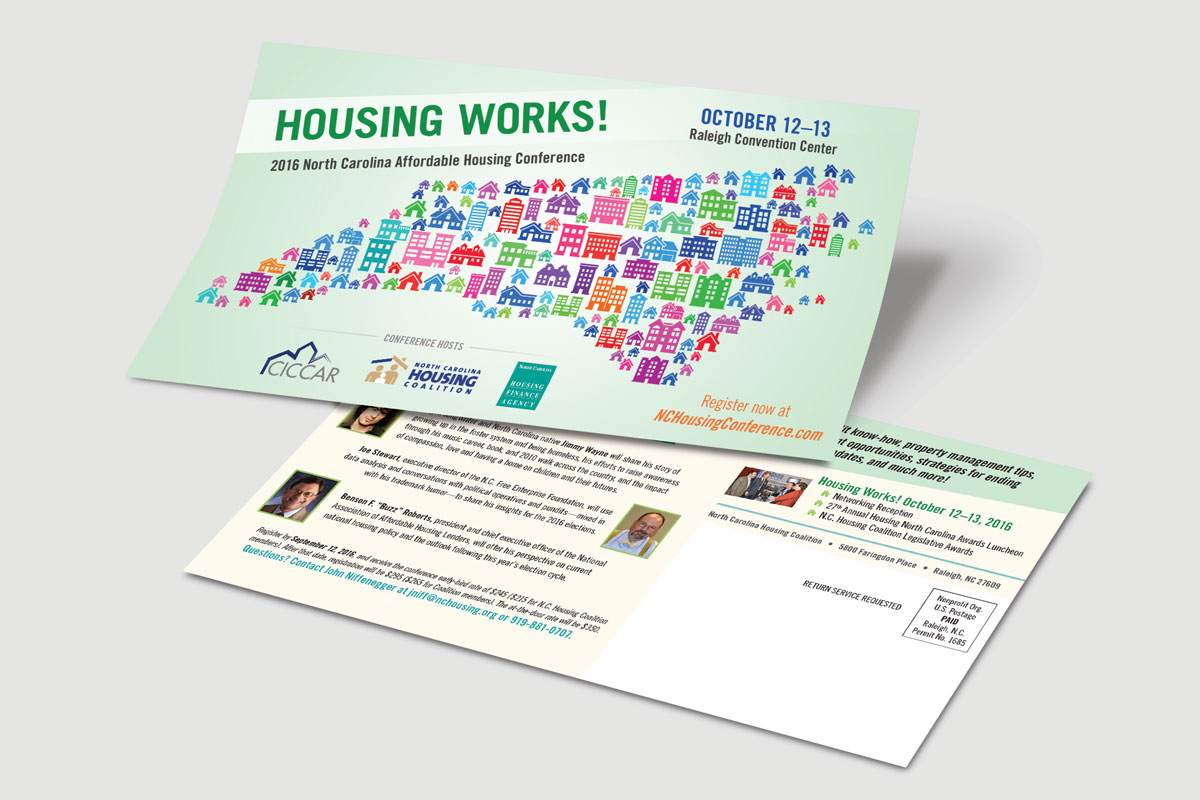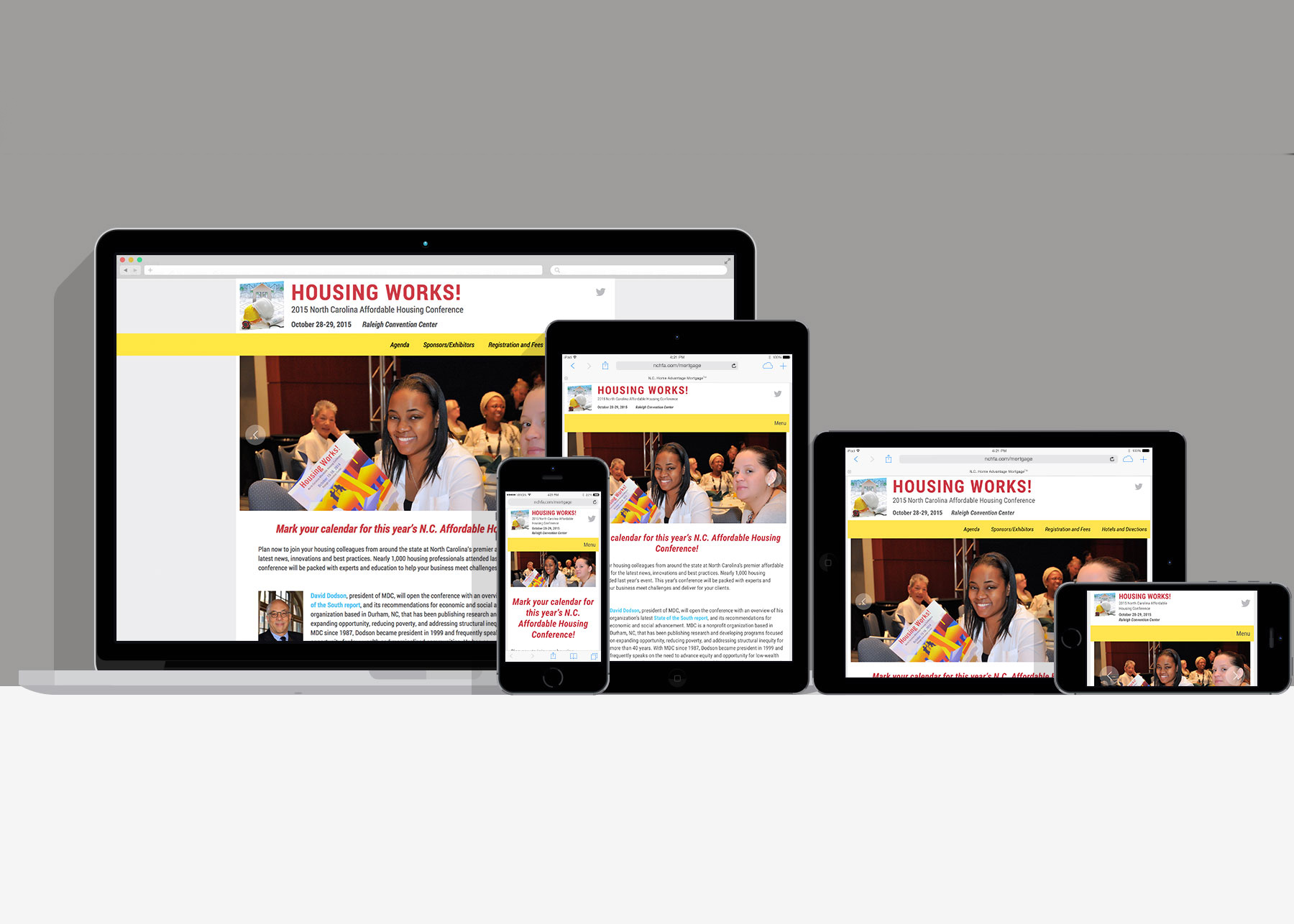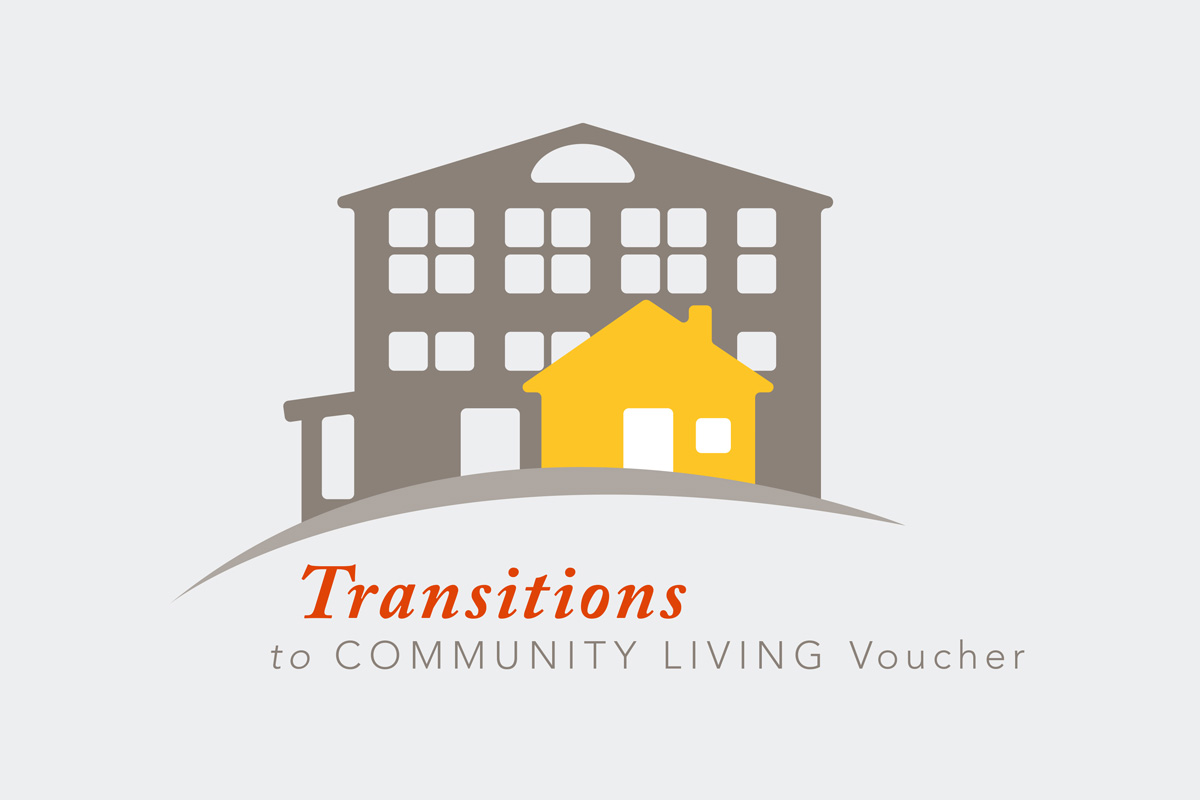NC Housing Finance Agency
Scope of Program: The North Carolina Foreclosure Prevention FundTM (the Fund) helps North Carolina homeowners who are struggling to make their mortgage payments due to job loss or temporary financial hardship. For qualified homeowners, the Fund can provide an interest-free loan to pay their mortgage and other related expenses while searching or retraining for new employment. For the currently employed, saddled with a second mortgage that is unaffordable because of a prior job loss or reduced income, the Fund offers interest-free loans to pay off the second mortgage. The Fund provides assistance at no cost to qualified homeowners. It is offered by the N.C. Housing Finance Agency (NCHFA) and funded by the U.S. Treasury.
Focus groups: Focus groups were conducted to test the message using the developed materials for the campaign. The groups were conducted at Foreclosure Prevention Fund counseling agencies in order to assure the participants matched the specific audience demographic.
Strategy: Radio, outdoor (billboard), print and online campaigns in the Triangle/Triad/Charlotte NC DMAs executed during 1st Q-2013. Radio used three :60-second radio spots produced with professional voice talent and studio production. Airing for 6 weeks (mid-March through April 2013) on selected stations and dayparts. To include matching pro bono PSAs, supplied web banner ads on each station's website, and Community Affairs program interviews with key NCHFA executives as part of the negotiated media package. Billboards show for a six (6) week period on major traffic arteries in the DMAs. Showings will also include PSA bonus showings on an inventory available basis using paper/vinyl sets supplied to the vendors to enhance and reinforce the outdoor campaign. Print ads will be placed in the major job search publications with free community distribution points. Most ads will be ½ page 4 color (4C). Online components will be banner ads (feature and footer sizes) on the publications’ radio and message-friendly community websites as well as the major online job search portals in the DMAs. All will link to the N.C. Foreclosure Prevention Fund website and will seek the best available rotation spots and cycles.
Goals: A) To bring in qualified applicants for the N.C. Foreclosure Prevention Fund Program, and B) To increase positive brand awareness and further penetrate the public's identification and association for the Fund program as an advocate for help to homeowners in very stressful financial times.
Audience Demographics: Age: The majority age group of borrowers is 43 - 52 years (34%). Overall, 88% are between the ages of 33 - 62. Average number of dependents: 2. Gender: Borrowers - 50-50 males-females; Co-Borrowers - Twice as many are females. Income levels: 90% of borrowers are below $50,000 (lower middle and middle). 89% of the borrowers have an annual income that is "Below 80% of the Area Median Income (AMI)." Education levels: Average 14 years (high school + two years) for the 12% who provided it. Race: 53% Caucasian, 36% African American, 3% Hispanic, 8% Other. Hardship: 85% listed "Unemployment" as the reason they are in danger of foreclosure.
Evaluation: Call centers have been established to "capture" program prospects into the system. The staff have been trained to use a specially prepared, brief, but specific script to query the prospects in order to capture data about the media that drove them, as a “call to action,” to make contact via phone. This information becomes part of a database that overlays activity onto the timeline in order to measure "spiked" activity against media vehicles to determine which were most successful and effective.
Results: Although success cannot be measured as a return on investment per se, the results have surpassed the projected and anticipated increase in the program’s a) awareness, and b) client identification and applications. It was particularly successful given the modest media budget allowed by the client's funding sources (usually the U.S. Treasury TARP funds in this case).
In summary a) the client was very pleased (always a goal of Sally Johns Design) b) client will definitely pursue further campaigns to broaden the same methods and message statewide after this pilot campaign as funding becomes available. Of course, and this is the key in this business, nothing expedites funding continuity and campaign expansion like a track record of proven results and successes.






NC Housing Finance Agency
Scope of Program: The North Carolina Foreclosure Prevention FundTM (the Fund) helps North Carolina homeowners who are struggling to make their mortgage payments due to job loss or temporary financial hardship. For qualified homeowners, the Fund can provide an interest-free loan to pay their mortgage and other related expenses while searching or retraining for new employment. For the currently employed, saddled with a second mortgage that is unaffordable because of a prior job loss or reduced income, the Fund offers interest-free loans to pay off the second mortgage. The Fund provides assistance at no cost to qualified homeowners. It is offered by the N.C. Housing Finance Agency (NCHFA) and funded by the U.S. Treasury.
Focus groups: Focus groups were conducted to test the message using the developed materials for the campaign. The groups were conducted at Foreclosure Prevention Fund counseling agencies in order to assure the participants matched the specific audience demographic.
Strategy: Radio, outdoor (billboard), print and online campaigns in the Triangle/Triad/Charlotte NC DMAs executed during 1st Q-2013. Radio used three :60-second radio spots produced with professional voice talent and studio production. Airing for 6 weeks (mid-March through April 2013) on selected stations and dayparts. To include matching pro bono PSAs, supplied web banner ads on each station's website, and Community Affairs program interviews with key NCHFA executives as part of the negotiated media package. Billboards show for a six (6) week period on major traffic arteries in the DMAs. Showings will also include PSA bonus showings on an inventory available basis using paper/vinyl sets supplied to the vendors to enhance and reinforce the outdoor campaign. Print ads will be placed in the major job search publications with free community distribution points. Most ads will be ½ page 4 color (4C). Online components will be banner ads (feature and footer sizes) on the publications’ radio and message-friendly community websites as well as the major online job search portals in the DMAs. All will link to the N.C. Foreclosure Prevention Fund website and will seek the best available rotation spots and cycles.
Goals: A) To bring in qualified applicants for the N.C. Foreclosure Prevention Fund Program, and B) To increase positive brand awareness and further penetrate the public's identification and association for the Fund program as an advocate for help to homeowners in very stressful financial times.
Audience Demographics: Age: The majority age group of borrowers is 43 - 52 years (34%). Overall, 88% are between the ages of 33 - 62. Average number of dependents: 2. Gender: Borrowers - 50-50 males-females; Co-Borrowers - Twice as many are females. Income levels: 90% of borrowers are below $50,000 (lower middle and middle). 89% of the borrowers have an annual income that is "Below 80% of the Area Median Income (AMI)." Education levels: Average 14 years (high school + two years) for the 12% who provided it. Race: 53% Caucasian, 36% African American, 3% Hispanic, 8% Other. Hardship: 85% listed "Unemployment" as the reason they are in danger of foreclosure.
Evaluation: Call centers have been established to "capture" program prospects into the system. The staff have been trained to use a specially prepared, brief, but specific script to query the prospects in order to capture data about the media that drove them, as a “call to action,” to make contact via phone. This information becomes part of a database that overlays activity onto the timeline in order to measure "spiked" activity against media vehicles to determine which were most successful and effective.
Results: Although success cannot be measured as a return on investment per se, the results have surpassed the projected and anticipated increase in the program’s a) awareness, and b) client identification and applications. It was particularly successful given the modest media budget allowed by the client's funding sources (usually the U.S. Treasury TARP funds in this case).
In summary a) the client was very pleased (always a goal of Sally Johns Design) b) client will definitely pursue further campaigns to broaden the same methods and message statewide after this pilot campaign as funding becomes available. Of course, and this is the key in this business, nothing expedites funding continuity and campaign expansion like a track record of proven results and successes.






